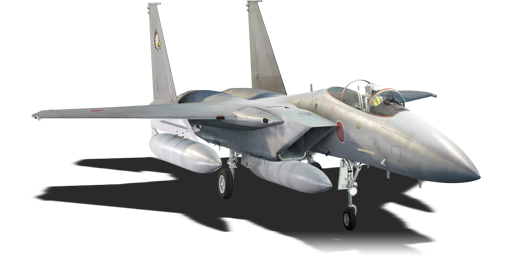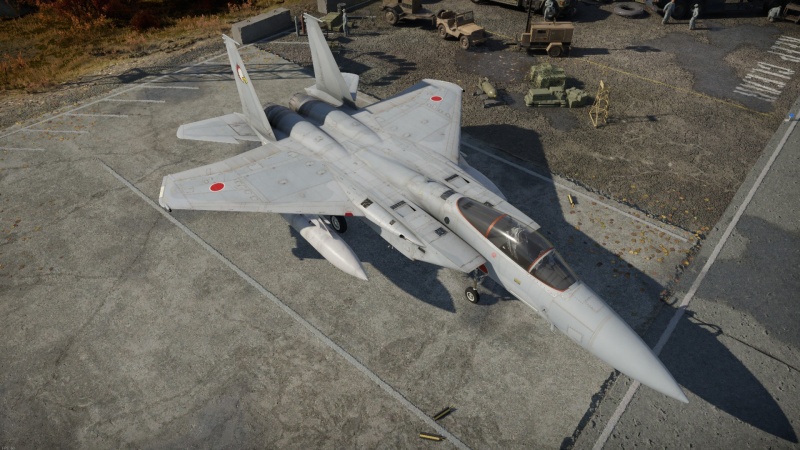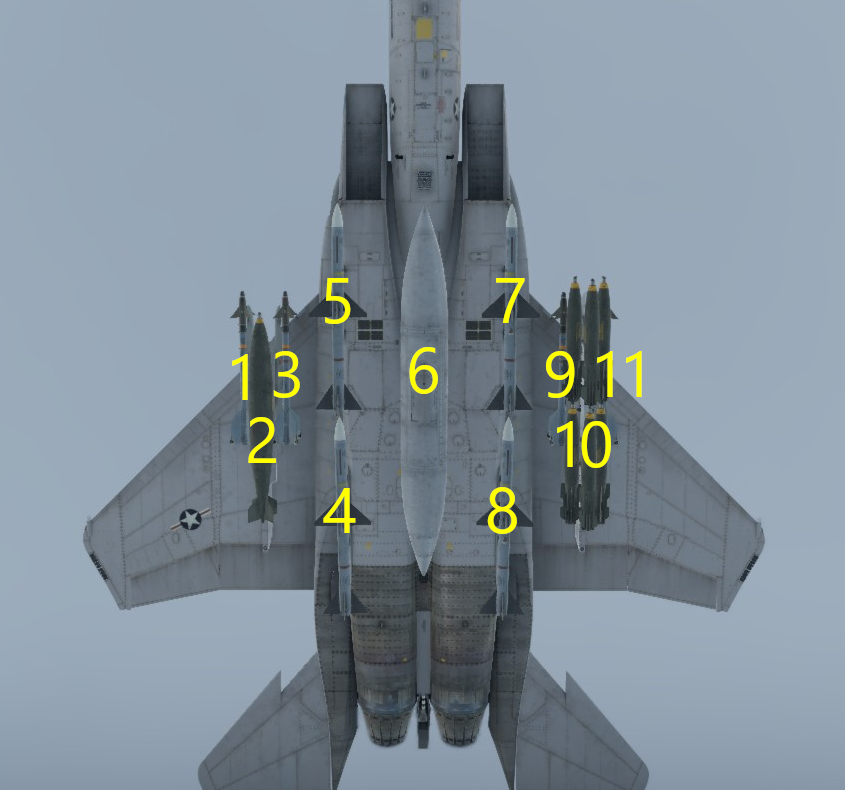F-15J
Contents
Description
The F-15J Eagle
is a variant of the American F-15 Eagle, customized for the Japan Air Self-Defense Force and produced under a licensing agreement with the United States, with Mitsubishi Heavy Industries taking the lead in manufacturing. The F-15J, which entered service in the early 1980s, was designed to replace Japan's aging fleet of F-104J Starfighters and F-4EJ Phantoms. This twin-engine, all-weather air superiority fighter features advanced radar and avionics for long-range engagement. The aircraft's design emphasizes air-to-air combat capabilities, featuring a mix of short and medium-range missiles, such as the AIM-9 Sidewinder and AIM-7 Sparrow, respectively on top of the domestic AAM-3 missile.
In game the F-15J is the crown jewel of the Japanese Air Tree. This translates to a very fast dedicated Air Superiority fighter, that is suprisingly nimble for such a heavy machine. It remains a very capable jet even when compared to it's competition like the SU-27 and the JAS39 Gripen. It is also the only plane featuring the AAM-3 domestic japanese missile in game.
It was introduced in Update "Air Superiority" and is the most advanced aircraft of the japanese Air tree, sitting at a battle rating of 12.3 (AB/RB/SB).
General info
Flight performance
The F-15J is a heavy aircraft, that is quite nimble for it's size. It can pull surprisingly well for it's weight and size. It can also rip between mach 1.0 and 1.1 with a combination of elevator, rudder and ailerons.
It also wants to pull very hard around 800km/h IAS.
| Characteristics | Max speed (km/h at _,___ m) |
Max altitude (metres) |
Turn time (seconds) |
Rate of climb (metres/second) |
Take-off run (metres) | |||
|---|---|---|---|---|---|---|---|---|
| AB | RB | AB | RB | AB | RB | |||
| Stock | ___ | ___ | 16764 | __._ | __._ | __._ | __._ | ___ |
| Upgraded | ___ | ___ | __._ | __._ | __._ | __._ | ||
Details
| Features | |||||
|---|---|---|---|---|---|
| Combat flaps | Take-off flaps | Landing flaps | Air brakes | Arrestor gear | Drogue chute |
| _ | _ | _ | _ | _ | _ |
| Limits | ||||||
|---|---|---|---|---|---|---|
| Wings (km/h) | Gear (km/h) | Flaps (km/h) | Max Static G | |||
| Combat | Take-off | Landing | + | - | ||
| 0 | 700 | ___ | ___ | ___ | ~__ | ~__ |
| Optimal velocities (km/h) | |||
|---|---|---|---|
| Ailerons | Rudder | Elevators | Radiator |
| < ___ | < ___ | < ___ | - |
Engine performance
| Engine | Aircraft mass | |||||
|---|---|---|---|---|---|---|
| Engine name | Number | Basic mass | Wing loading (full fuel) | |||
| _____ | _ | _,___ kg | ___ kg/m2 | |||
| Engine characteristics | Mass with fuel (no weapons load) | Max Gross Weight | ||||
| Weight (each) | Type | _m fuel | __m fuel | __m fuel | ||
| ___ kg | ___ | _,___ kg | _,___ kg | _,___ kg | _,___ kg | |
| Maximum engine thrust @ 0 m (RB/SB) | Thrust to weight ratio @ 0 m (___%/WEP) | |||||
| Condition | 100% | ___%/WEP | _m fuel | __m fuel | __m fuel | MGW |
| Stationary | ___ kgf | ___ kgf | _.__ | _.__ | _.__ | _.__ |
| Optimal | ___ kgf (_ km/h) |
___ kgf (_ km/h) |
_.__ | _.__ | _.__ | _.__ |
Survivability and armour
The F-15 was designed with a focus on survivability. In real life this very jet landed without a wing. the pilots did not know the wing was missing until after they landed.
In game this plane is a tank compared to other jets. the F-15 can often survive non direct missile hits and still be operational enough to land, compared to an F-16 or a Mirage 2000 that will not like flying if they have damaged wings. The F-15 has no armor protection, but the high amount of countermeasures (x240) helps with decoying incoming missiles.
Overall, the F-15 is one of the most survivable aircraft of top tier, being able to withstand more damage than other jets.
Modifications and economy
Armaments
| Ballistic Computer | ||||
|---|---|---|---|---|
| CCIP (Guns) | CCIP (Rockets) | CCIP (Bombs) | CCRP (Bombs) | Lead indicator |
| |
|
|
|
|
Offensive armament
The F-15J is armed with:
- 1 x 20 mm JM61A1 cannon, wing root-mounted (940 rpg)
- 240 x countermeasures
Suspended armament
The F-15J can be outfitted with the following ordnance:
| 1 | 2 | 3 | 4 | 5 | 6 | 7 | 8 | 9 | 10 | 11 | ||
|---|---|---|---|---|---|---|---|---|---|---|---|---|
| 500 lb LDGP Mk 82 bombs | 1, 6 | 1, 6 | 1, 6 | |||||||||
| 500 lb Mk 82 Snakeye bombs | 1, 6 | 1, 6 | 1, 6 | |||||||||
| 2,000 lb LDGP Mk 84 bombs | 1 | 1 | 1 | |||||||||
| BLU-27/B incendiary bombs | 3 | 3 | 3 | |||||||||
| AAM-3 missiles | 1 | 1 | 1 | 1 | ||||||||
| AIM-7M Sparrow missiles | 1 | 1 | 1 | 1 | ||||||||
| AIM-9L Sidewinder missiles | 1 | 1 | 1 | 1 | ||||||||
| AIM-9M Sidewinder missiles | 1 | 1 | 1 | 1 | ||||||||
| 610 gal drop tanks | 1* | 1 | 1* | |||||||||
| Maximum permissible loadout weight: 5,448 kg Maximum permissible weight imbalance: 1,000 kg | ||||||||||||
| * Wing-mounted drop tanks must be equipped together | ||||||||||||
| Default weapon presets | |
|---|---|
| |
The F-15J has very basic armament loadouts. It gets access to some of the best IR missiles in game being the AAM-3, which are in game feel like an improved version of the famous Aim-9m. In terms of SARH missiles, the Aim-7M are the only possible missiles.
In terms of Air to Ground missiles, the F-15J has 3x hardpoints that can carry up to 3x 2000LBS bombs, up to 18x 500LBS bombs or up to 9x BLU-27/B incendiary bombs.
The F-15J also has access to up to 3x Drop tanks.
Usage in battles
The F-15J is a top tier aircraft that that can punch above it's weight. It is a big and heavy aircraft, that has all of the features a top tier competitive jet needs for Air to Air combat. It gets access to 8x Air to Air missiles total, a good amount of flares and has a good flight model.
One might think the F-15J would be bad at dogfighting, however due to it's design it can fight surprisingly well for such a big plane. It can have a hard time against planes that can pull a lot of AOA (Angle of Attack) like the SU-27, or the JAS-39, however due to the powerful engines of the F-15J, such enemies will have a hard time keeping up with the Eagle in the long run.
The F-15 flight model can be compared to a combination of an F-4 and an F-16. It is a brick, like the F-4, however it turns extremely well under the right circumstances, like an F-16.
- The F-15J does not have a lot of playstyles due to it's limitations. It should be used as a "boom and zoom" plane. the F-15J should never be inside the "furball" that forms in the first minutes of the match, however the pilot of the F-15 should be ready to at any moment after the formation of the "furball" be ready to speed towards it in order to fire some AAM-3 missiles and maybe Aim-7M missiles. After passing through the furball and dodging incoming missiles, the pilot should keep it's energy up, and go back again to try and destroy some more targets. It is also possible to grab 12x 500LBS bombs in order to destroy one base for some extra RP and SL, and then proceed to fight the enemy planes. Generally 40 minutes of total fuel is enough for a match of Air Realistic battles. Each drop tank has around 11 minutes of fuel.
- The F-15J should can be a good Interceptor in Ground Realistic battles, however the F-16AJ outclasses the F-15J due to it's AGM-65B.
The F-15J is quite a specialized Aircraft, tailor made for Air Superiority due to it's armament. It is a competitive Jet that has it's own quirks and few compromises, but it is very scary in the hands of a good pilot. Overall an aircraft with a lot of potential.
Pros and cons
The F-15J is a slightly niche Aircraft, that specializes in Air Superiority.
Pros:
- Very high thrust-to-weight ratio, allowing very high acceleration, rapid climbing and dogfight endurange
- High amount of countermeasures (x240) allowing it to decoy missiles reliably
- AAM-3 missiles. The AAM-3 can be described as an improved AIM-9M with better turning capability.
- High amount of fuel, making it possible to afterburn for longer than the average air RB match. (~18minutes)
- Good manoeuvrability for such a big and heavy jet fighter. It has the capability of out-manoeuvering lighter or more nimble opponents.
- High Ammo Count. 940x Rounds.
Cons:
- Heavy weight. The F-15J remains a very heavy plane, that in some cases does not want to do what the pilot wants it to.
- No Guided Air to Ground Armament
- Tends to Compress at speeds above mach 1.
History
The F-15J Eagle, a cornerstone of Japan's air defense, represents a pivotal chapter in the Japan Air Self-Defense Force's (JASDF) history. This twin-engine, all-weather air superiority fighter, a variant of the American McDonnell Douglas F-15 Eagle, emerged from Japan's strategic need to modernize its air capabilities in the 1970s. During this period, Japan was in the process of phasing out its aging fleet of F-104J Starfighters and F-4EJ Phantoms. After a thorough evaluation of various options, including the F-14 Tomcat and F-16 Fighting Falcon, the JASDF settled on the F-15 Eagle, primarily for its unmatched air superiority.
The journey of the F-15J began with a landmark agreement in 1978 between Japan and the United States, allowing Japan to produce the fighter under license. This decision was more than a mere procurement choice; it was a strategic maneuver aimed at bolstering Japan’s domestic aerospace industry. Mitsubishi Heavy Industries was entrusted with the manufacturing, marking a significant step in Japan's post-war industrial and defense capabilities. The initial batch of F-15Js was assembled in the United States and then shipped to Japan for final assembly, but subsequent units were wholly constructed in Japan, showcasing the country's growing technical prowess.
The F-15J was tailored to meet specific Japanese requirements. It incorporated indigenous electronic warfare systems, radar, and other avionics, distinguishing it from its American counterpart. However, in line with Japan's defense-oriented policy, certain features like in-flight refueling were initially left out.
Inducted into service in 1982, the F-15J swiftly became the backbone of Japan's air superiority. Over the years, it underwent several upgrades, enhancing its radar, avionics, and weapon systems to keep pace with global technological advancements. The F-15J's role extended beyond mere hardware; it was integral in joint training exercises with the United States and other allies, honing the JASDF's tactical capabilities and ensuring interoperability.
A key aspect of the F-15J's operational history is its role in air defense. Tasked with safeguarding Japan's airspace, it has been routinely scrambled to intercept foreign military aircraft, particularly Russian and Chinese, near Japanese territory. However, in alignment with Japan's post-World War II pacifist constitution, the F-15J has not been engaged in active combat. Its use has been strictly limited to defensive and deterrence missions.
Looking to the future, Japan has initiated an ambitious modernization program for its F-15J fleet. This program aims to equip the fighters with advanced electronics, radar systems, and the ability to carry more sophisticated weaponry. Yet, as the defense landscape evolves, discussions about the F-15J's role in Japan's future air defense strategy continue, with potential transitions to newer platforms like the F-35 Lightning II being considered.
In summary, the F-15J Eagle stands as a testament to Japan's strategic defense evolution, symbolizing the nation's commitment to maintaining a robust air defense capability while adhering to its foundational principles of self-defense and regional stability.
Media
Excellent additions to the article would be video guides, screenshots from the game, and photos.
See also
Links to the articles on the War Thunder Wiki that you think will be useful for the reader, for example:
- reference to the series of the aircraft;
- links to approximate analogues of other nations and research trees.
External links
| McDonnell Aircraft Corporation | |
|---|---|
| Jet Fighters | F2H-2 · F3H-2 |
| F-4C Phantom II · F-4E Phantom II · F-4J Phantom II · F-4S Phantom II | |
| F-15A · F-15C MSIP II · F-15E | |
| Strike Aircraft | AV-8B Plus · AV-8B (NA) |
| Helicopters | AH-6M |
| Export/Licensed | |
| Aircraft | ◄F-4F Early · ◄F-4F · ◄F-4F KWS LV · Phantom FG.1 · Phantom FGR.2 · F-4J(UK) Phantom II · F-4EJ Phantom II · F-4EJ ADTW · Kurnass · Kurnass 2000 |
| F-15J · F-15J(M) · Baz · Baz Meshupar · F-15I Ra’am | |
| ▄AV-8B Plus | |
| Helicopters | Lahatut |
| The McDonnell Aircraft Corporation merged with Douglas Aircraft Company in 1967 to form McDonnell Douglas Corporation. Later it was merged with The Boeing Company in 1997. | |
| See Also | Mitsubishi Heavy Industries |
| Japan jet aircraft | |
|---|---|
| IJNAS | |
| Experimental | Kikka |
| Reconnaissance | R2Y2 Kai V1 · R2Y2 Kai V2 · R2Y2 Kai V3 |
| IJAAS | |
| Fighters | Ki-200 |
| JASDF | |
| Fighters | F-86F-30 ▅ · F-86F-40 ▅ · F-86F-40 JASDF▅ |
| F-104J | |
| F-4EJ Phantom II · F-4EJ ADTW · F-4EJ Kai Phantom II | |
| F-15J · F-15J(M) | |
| F-16AJ | |
| F-1 | |
| Trainers | T-2 Early · T-2 |
| Foreign | |
| Thailand | ▄AV-8S · ▄F-5E FCU |






